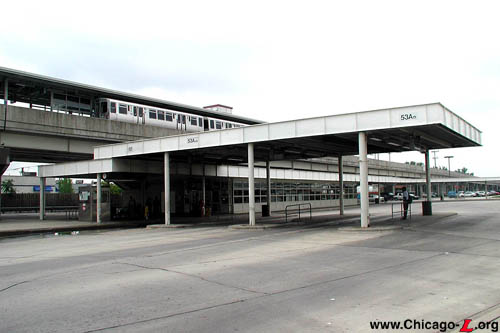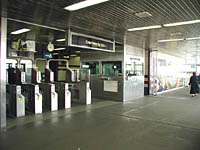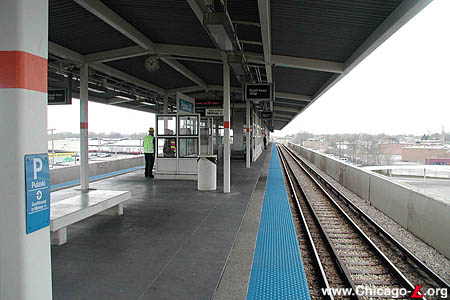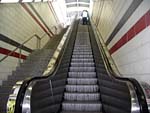
Pulaski station is seen here
on June 11, 2004, looking southwest from the plaza in front
of the station as an outbound train departs. The bus
terminal in front of the station is typical for the
intermodally-oriented Orange Line stations. For a larger
view, click here.
(Photo by Graham Garfield)
|
Pulaski
(5100S/4000W)
Pulaski Road and 51st
Street, Archer Heights/West Elsdon
Service
Notes:

|
Orange Line:
Midway
|

|
Accessible
Station
|

|
Park'n'Ride: 390
spaces
|
Quick Facts:
Address: 5106 S. Pulaski
Road
Established: October 31, 1993
Original Line: n/a
|
Skip-Stop
Type:
|

|
Station
|
Rebuilt: n/a
Status: In Use
History:
In 1993, the CTA completed
the new Orange Line, built relatively inexpensively (about $500
million) using old abandoned railroad rights-of-ways, including those
previously used by the Illinois Central Railroad, Santa Fe Railway
and the Belt Railway of Chicago.
One of seven stations on the line, Pulaski is typical of the
facilities designed and built for the line, originally called the
Southwest Rapid Transit line before adopting the
CTA's then-new color
designation shortly before opening. The stations, designed in the
late 1980s and early 1990s, are typical of urban design in general
and transit planning in particular during that period. The stations
are designed to be intermodal and encourage rail-bus transferring,
with off-street bus terminals connected to them. Most stations, like
Pulaski, were also designed with sizable park'n'ride lots, owing to
transit's postwar philosophy of sometimes trying to cooperate with
the automobile to generate traffic rather than always trying to rival
it. So successful were the park'n'ride lots at most stations that
some of those on the Orange Line that didn't open with them had them
added later. The station houses are also set far back from the
street, catering far more to the transferring bus passengers and
park'n'ride users than to walk-in traffic. This has the effect of
disassociating the stations from the surrounding neighborhood and
disallowing the station from contributing from the streetlife and
presence along Pulaski Road or 51st Street. (In all fairness, the
areas that a few of the Orange Line stations are situated in are
remote and have little pedestrian traffic to speak of, but Pulaski is
not one of these.) In front of the station is a large, open plaza,
but except for a couple trees in raised planters it is an extremely
stark, barren environment of flat concrete. In the plaza, on the
corner of Pulaski and 51st, is a tall blue identification pylon
denoting the presence of the station. This type of pylon was
installed at all Orange Line stations and was to become standard for
the CTA, but with the
exception of one installed (and since removed) at Dempster-Skokie
they never proliferated and have since fallen into disuse.

The interior of the Pulaski
station house seen on April 18, 2003, looking at the fare
controls from the unpaid area. The interiors and finishes
are very rectilinear, typical for Orange Line stations. The
artwork on the wall was added after the station opened. For
a larger view, click here.
(Photo by Graham Garfield)
|
The station facility was designed by the City, who encouraged the
architects to use distinctive styles for the stations while
conforming to a basic uniform layout and footprint. The station house
has a long facade of glass windows framed by steel panels and
mullions facing the bus terminal. The headhouse, most of which is
situated underneath the concrete elevated structure, is topped with a
steel box cornice. This cornice and roof extends east of the station
building to create a covered walkway to the bus terminal and to the
west to cover part of the walk to the park'n'ride lot. A similar
steel box-shaped structure is set perpendicular to and partially
overlaps the east eave and constitutes the canopy over the bus
bays.
The interior of the station house is simple and typical of all Orange Line stations. The floors are concrete and the ceilings are
made up of metal strip panels. The walls that do not have large
picture windows are clad with simple, utilitarian tile. As in most Orange Line stations, the tile is white except for a very simple
pattern that is unique to each station. In the case of Pulaski, this
is a single band of gray tile and a band of dark red tile, separated
by one course of white tile. Also, the bottom three courses of tile
nearest the floor are dark gray. Otherwise, the walls are all-white.
Finishes in the building, such as the grilles, sign boxes, and the
agent's booth, are stainless steel and tend to rectilinear in design.
The original turnstiles, replaced in 1997 with AFC Cubic-made
TransitCard turnstiles, were also very rectilinear. The booths are
significant in that they were the first specifically designed not to
primarily function as fare collection facilities. Although there were
still ticket agents at the time and "Customer Assistants" as we know
them today would not exist for another four years after the station
opened, the Orange Line was the first to prepare for the time when
fare collection would be more automated. The agent in the booth did
not collect fares, though they did verify reduced fare eligibility
and accept transfers, and functioned more as an information
assistant. Fares were to be paid at the turnstiles, and individuals
that did not have exact change could use one of the Orange Line's
specially-installed token vending machines. Following the
installation of the AFC equipment, these machines were removed and
standard TransitCard Vending Machines (TCVMs) were installed. The
station also has a concession space, originally had a payment station
for the park'n'ride (later relocated to the parking lot), and later
had community artwork installed. Two pairs of stairs and escalators
lead to the platform, as well as an elevator, making the station ADA
compliant and accessible.
The platform is of the island variety, with a concrete deck and a
full-length canopy. The canopy has a gable roof supported by two rows
of square steel columns. The canopy extends out to the centerline of
each track. The platform is outfitted with flat concrete slab benches
and glass and steel windbreaks, shaped like an "H" if viewed in plan,
with a panel on top that holds a station name sign inside a frame.
Behind each stairway is another windbreak waiting area.
The Pulaski station is on a busy commercial street lined with
strip malls and detached, setback buildings in the Archer Heights
neighborhood, close to a residential communities inhabited by blue-
and white-collar workers and near the West Elsdon neighborhood. The
station is also near Curie High School, one of the city's large
magnet schools.
At its June 4 , 2003 monthly meeting, the Chicago Transit Board
approved a $569,973 contract for Chicago-based Camp Dresser &
McKee, Inc. to design and prepare construction bid documents for the
CTA's "Front Door Program"
that will add amenities to station entrances throughout the rail
system. Seven stations were scheduled for entrance upgrades as part of
the initiative, including Pulaski. Funding for this contract is
provided by the FTA and the Regional Transportation Authority
(RTA). The improvements were designed but never performed, with the project funds diverted to other needs.
In late Spring 2005, the station name signs and column signs on
the platform were replaced, with Green Line
Graphic Standard signs replacing the Modified
KDR Standard originals. Likewise, the original Modified
KDR graphics of the station's backlit entrance signs were
replaced with the newest Green Line
Graphic Standard variety, listing the station's name, in January
2006.
Although the companies the
CTA has contracted with over
the years to handle their station and railcar advertising -- Obie,
Viacom, CBS
Outdoor Advertising and most recently Titan Worldwide -- have long had the right to install
advertising frames and ads at Orange Line stations, this right was
not exercised for over a decade, leaving the Orange Line stations
ad-free, somewhat of an anomaly on the "L" system. CBS Outdoor
fulfilled this contract option in June 2006, installing
freestanding advertising panels at all Orange Line station platforms
except Midway (where there is insufficient
room). The panels are lined up along the centerline of the platform,
between the already-present benches, trashcans, windbreaks,
elevators, and stair/escalator enclosures.

Pulaski station's platform,
with its wide concrete platform and full-length gable roof,
is typical of those built on the Orange Line. This view
looks southwest on April 18, 2003. For a larger view, click
here.
(Photo by Graham Garfield)
|


|
pulaski-51st03.jpg
(168k)
This April 18, 2003 view looking up one of the
two stair/escalator sets up to the island platform shows the
Pulaski wall tile pattern, large plain white tiles with two
simple stripes of gray and dark red. (Photo
by Graham Garfield)
|

|
pulaski-51st05.jpg
(142k)
The Orange Line stations tended to be set way
back from the streets they were meant to serve. Often, they
had plazas in front of them, but to save on landscaping
maintenance they were usually a plain, flat field of
concrete. The wide expanse of Pulaski's plaza, broken only
by a few trees in raised planters, is seen here looking west
from Pulaski Road on June 11, 2004. (Photo
by Graham Garfield)
|

- Pulaski-51.wav
(548k): "This is Pulaski." ... doors open ... "Doors
Closing." This sound is interesting because it gives you an
idea of what kind of standing time there is at each station stop.
(Sound courtesy of Tony Coppoletta)
.
- Pulaski-51_doors.wav
(42k): "In the direction of travel, doors open on the left
at Pulaski." (Sound courtesy of Tony Coppoletta)







